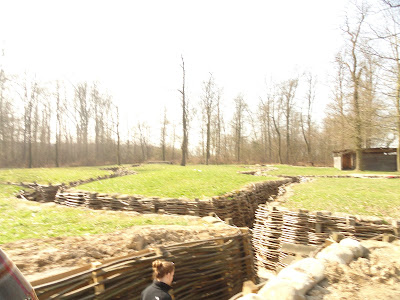


 So the English did something quite horrid in Langemarck. ROTCs from Berlin University (students exactly my age) were sent by their officer toward British troops. They were outnumbered and inexperienced. The British rounded them up, and shot them all. The first two pictures are from the memorial to them, and I even found a Bayer, Leonard. The rest of the cemetery is dedicated to other German casualties, where I found 13 Bayers, my father's mother's maiden name. When I get back to the states I want to look them up to see if there's any relation: Adolf Bayer, Andreas Bayer, Anton Bayer, Emil Bayer, Ernst Bayer, Friedrich Bayer, George Bayer, Heinrich Bayer, Heinrich Bayer, Hermann Bayer, Jakob Bayer, Jakob Bayer, and Johann Bayer.
So the English did something quite horrid in Langemarck. ROTCs from Berlin University (students exactly my age) were sent by their officer toward British troops. They were outnumbered and inexperienced. The British rounded them up, and shot them all. The first two pictures are from the memorial to them, and I even found a Bayer, Leonard. The rest of the cemetery is dedicated to other German casualties, where I found 13 Bayers, my father's mother's maiden name. When I get back to the states I want to look them up to see if there's any relation: Adolf Bayer, Andreas Bayer, Anton Bayer, Emil Bayer, Ernst Bayer, Friedrich Bayer, George Bayer, Heinrich Bayer, Heinrich Bayer, Hermann Bayer, Jakob Bayer, Jakob Bayer, and Johann Bayer. Both the British and the Germans respect each other by laying poppies at each others' memorials and cemeteries. They both know the tragedy and pointlessness of WWI and seek peace and respect for one another.



















